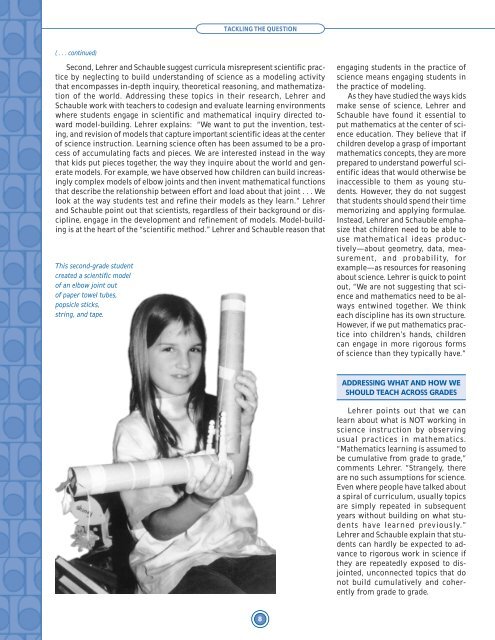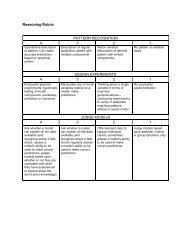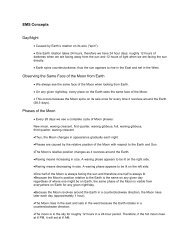Science Education Reform - National Center for Improving Student ...
Science Education Reform - National Center for Improving Student ...
Science Education Reform - National Center for Improving Student ...
You also want an ePaper? Increase the reach of your titles
YUMPU automatically turns print PDFs into web optimized ePapers that Google loves.
TACKLING THE QUESTION<br />
( . . . continued)<br />
Second, Lehrer and Schauble suggest curricula misrepresent scientific practice<br />
by neglecting to build understanding of science as a modeling activity<br />
that encompasses in-depth inquiry, theoretical reasoning, and mathematization<br />
of the world. Addressing these topics in their research, Lehrer and<br />
Schauble work with teachers to codesign and evaluate learning environments<br />
where students engage in scientific and mathematical inquiry directed toward<br />
model-building. Lehrer explains: “We want to put the invention, testing,<br />
and revision of models that capture important scientific ideas at the center<br />
of science instruction. Learning science often has been assumed to be a process<br />
of accumulating facts and pieces. We are interested instead in the way<br />
that kids put pieces together, the way they inquire about the world and generate<br />
models. For example, we have observed how children can build increasingly<br />
complex models of elbow joints and then invent mathematical functions<br />
that describe the relationship between ef<strong>for</strong>t and load about that joint . . . We<br />
look at the way students test and refine their models as they learn.” Lehrer<br />
and Schauble point out that scientists, regardless of their background or discipline,<br />
engage in the development and refinement of models. Model-building<br />
is at the heart of the “scientific method.” Lehrer and Schauble reason that<br />
This second-grade student<br />
created a scientific model<br />
of an elbow joint out<br />
of paper towel tubes,<br />
popsicle sticks,<br />
string, and tape.<br />
engaging students in the practice of<br />
science means engaging students in<br />
the practice of modeling.<br />
As they have studied the ways kids<br />
make sense of science, Lehrer and<br />
Schauble have found it essential to<br />
put mathematics at the center of science<br />
education. They believe that if<br />
children develop a grasp of important<br />
mathematics concepts, they are more<br />
prepared to understand powerful scientific<br />
ideas that would otherwise be<br />
inaccessible to them as young students.<br />
However, they do not suggest<br />
that students should spend their time<br />
memorizing and applying <strong>for</strong>mulae.<br />
Instead, Lehrer and Schauble emphasize<br />
that children need to be able to<br />
use mathematical ideas productively—about<br />
geometry, data, measurement,<br />
and probability, <strong>for</strong><br />
example—as resources <strong>for</strong> reasoning<br />
about science. Lehrer is quick to point<br />
out, “We are not suggesting that science<br />
and mathematics need to be always<br />
entwined together. We think<br />
each discipline has its own structure.<br />
However, if we put mathematics practice<br />
into children’s hands, children<br />
can engage in more rigorous <strong>for</strong>ms<br />
of science than they typically have.”<br />
ADDRESSING WHAT AND HOW WE<br />
SHOULD TEACH ACROSS GRADES<br />
Lehrer points out that we can<br />
learn about what is NOT working in<br />
science instruction by observing<br />
usual practices in mathematics.<br />
“Mathematics learning is assumed to<br />
be cumulative from grade to grade,”<br />
comments Lehrer. “Strangely, there<br />
are no such assumptions <strong>for</strong> science.<br />
Even where people have talked about<br />
a spiral of curriculum, usually topics<br />
are simply repeated in subsequent<br />
years without building on what students<br />
have learned previously.”<br />
Lehrer and Schauble explain that students<br />
can hardly be expected to advance<br />
to rigorous work in science if<br />
they are repeatedly exposed to disjointed,<br />
unconnected topics that do<br />
not build cumulatively and coherently<br />
from grade to grade.<br />
8





